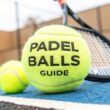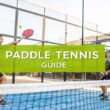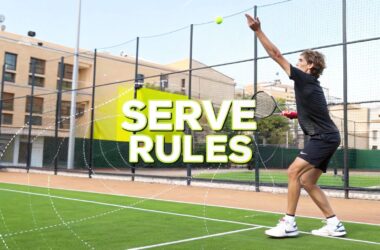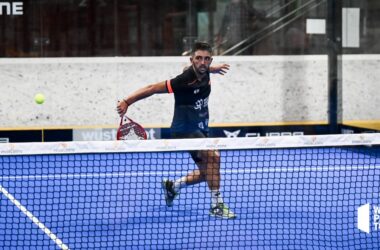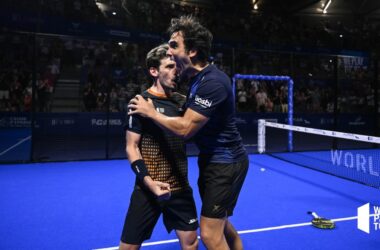It all boils down to a simple truth: you need to train your body to move explosively and train your brain to process information faster. If you can master that combination, your reaction time on the padel court will skyrocket.
Let's dive into a structured plan filled with specific drills and exercises designed to sharpen those crucial reflexes.
The Foundations of a Faster Padel Game
Ever feel like you’re just a half-step behind on a lightning-fast volley or a surprise lob? That split-second hesitation is often the only thing separating a winning shot from a lost point. Getting faster isn't some secret trick; it's about systematically training your entire neuromuscular system—your eyes, brain, and muscles—to fire in perfect sync.
We'll break this down into four practical, easy-to-follow areas:
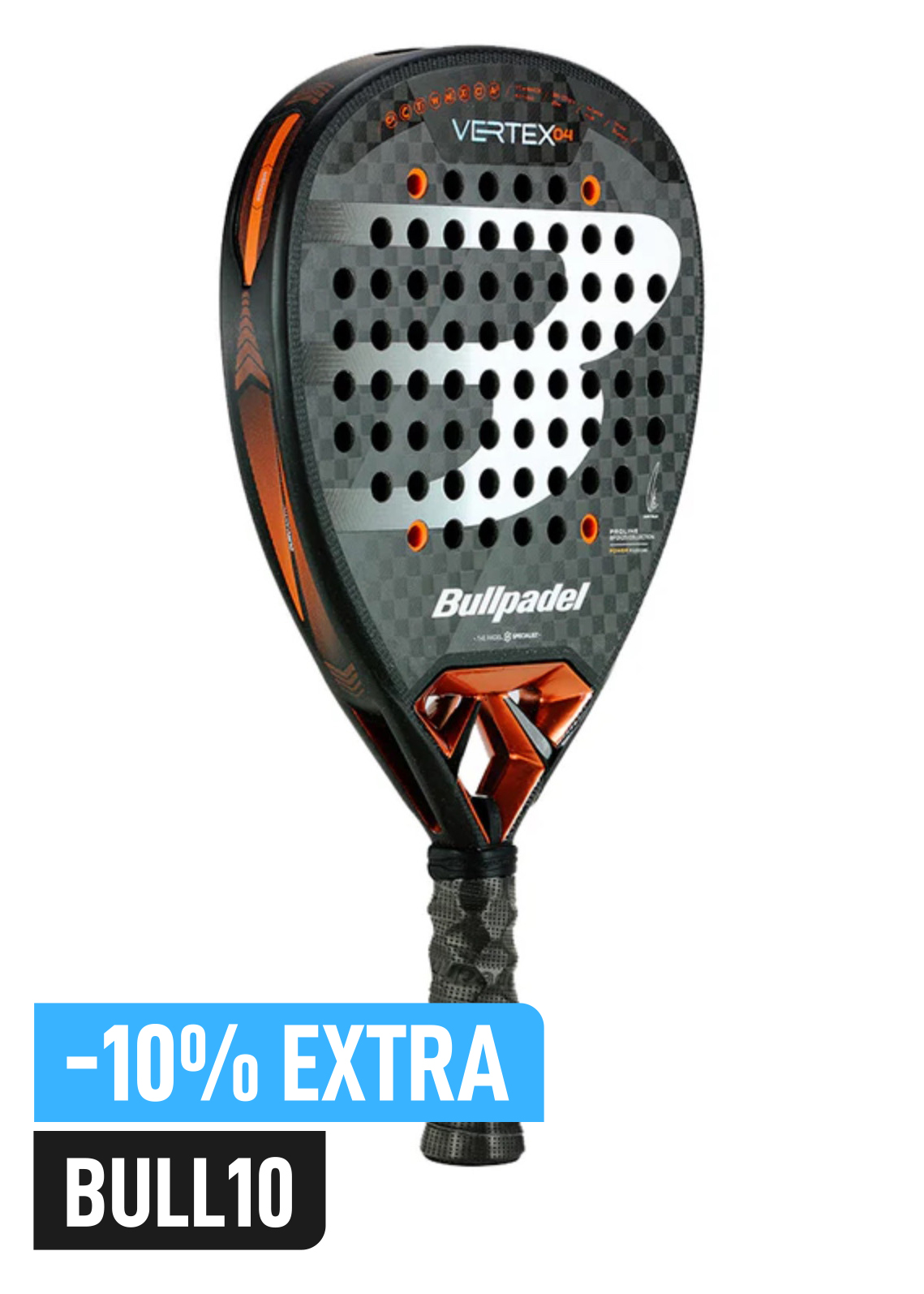
Buy the best padel gear to level up your next game!
CHECK OUT this deal from Padel Market!Get ready to take your game to the next level with the latest padel gear from Padel Market! Fast EU and Worldwide Shipping
- Dynamic Warm-ups: Getting your body and mind primed for quick, explosive movements.
- On-Court Drills: Building game-ready reflexes right where you need them most.
- Cognitive Exercises: Sharpening your mental processing speed so you can decide and act faster.
- Tracking and Adaptation: Actually measuring your progress to make sure you're getting quicker.
How Fast is Humanly Possible?
Reaction time isn’t just a feeling; it’s a measurable biological process that scientists have been digging into for over a century. We’ve known since the 1800s, when Francis Galton clocked visual reaction times under 190 milliseconds, that humans can be incredibly fast.
Of course, things change. Modern research confirms that age plays a role, with studies showing a gradual 10% slowing from our peak. For a deeper dive, you can explore the full research on reaction time and age to see how these benchmarks were established.
This chart gives you a great visual of how reaction times are spread across a large population.
As you can see, most of us fall somewhere in the middle. The goal for any serious padel player is to push your own average firmly into the faster end of that curve through smart, targeted training.
To give you a clearer picture, here’s a quick overview of the key training components we’ll be focusing on.
Core Components for Improving Reaction Time
This table breaks down the essential elements of a solid reaction training plan. It’s a snapshot of what you should be doing, why, and how often.
| Component | Type | Duration | Frequency |
|---|---|---|---|
| Dynamic Warm-Up | Physical & Mental Prep | 10-15 min | Before every session |
| On-Court Drills | Sport-Specific Practice | 20-30 min | 2-3 times per week |
| Cognitive Training | Off-Court Brain Exercises | 10-15 min | 3-4 times per week |
| Progress Tracking | Measurement & Analysis | 5 min | Weekly |
Think of these as the building blocks of a faster you. Consistency across all four areas is what will ultimately deliver the biggest gains on the court.
Key Takeaway: Reaction time is a skill you can train. Your genetics and age might set the baseline, but dedicated practice can sharpen your reflexes in a big way. The following sections will give you the exact drills you need to make that happen.
Priming Your Body and Brain for Speed
Let's be honest: sharp, instinctive reactions on the padel court don't just happen. They’re built, deliberately, long before you even step on the court for the first point. Too many players treat their warm-up as a chore—a few lazy stretches and they're done. But if you're serious about boosting your reaction time, you need to see your warm-up as an active, focused process that ignites both your muscles and your mind.
Think of it as flicking a switch on your central nervous system. A proper warm-up tells your body and brain that it's go-time, preparing them to operate at a much higher level of alertness. Static stretching just won't cut it here.
Beyond Basic Stretches to Dynamic Activation
The real goal is to shift from a state of rest to a state of readiness. This demands dynamic movements that actually mimic the explosive actions you’ll be making during a match. Those static stretches where you hold a position? Save them for your cool-down. Before a match, you need to get your blood flowing, raise your core temperature, and fire up the specific muscle groups you rely on in padel.
This is about preparing for sudden lunges, quick pivots, and explosive shots. You're not just limbering up muscles; you're greasing the neural pathways that control them.
A solid warm-up flow I've seen work wonders for players includes things like:
- Leg Swings (Forward and Sideways): These are fantastic for opening up the hips and hamstrings, which is non-negotiable for getting down to low volleys and making quick lateral dashes.
- Walking Lunges with a Torso Twist: This is a great all-in-one. It gets your glutes, quads, and core working together while improving the rotational mobility you need for powerful smashes.
- High Knees and Butt Kicks: Don't underestimate these classics. They jack up your heart rate and wake up those crucial fast-twitch muscle fibers.
- Arm Circles (Forward and Backward): Absolutely essential for preparing your shoulder joint for the unique demands of serves and bandejas.
This screenshot gives you a good visual of different dynamic exercises you can pull from for your own padel-specific routine.
Every one of these movements helps build that state of physical readiness, so your body can react without any stiffness holding you back. Remember, the key is fluid, controlled motion, not static holds.
The Role of Resistance Bands in Padel Warm-Ups
Want to take your warm-up to the next level? Grab some light resistance bands. They are incredible tools for activating the smaller, stabilizing muscles that often get ignored. These little guys are vital for preventing injuries and allowing you to change direction on a dime.

Buy the best padel gear to level up your next game!
CHECK OUT this deal from Padel Market!Get ready to take your game to the next level with the latest padel gear from Padel Market! Fast EU and Worldwide Shipping
I’m a huge fan of band-resisted footwork drills. Try placing a mini-band around your ankles or just above your knees while you do side shuffles. You'll immediately feel your hip abductors and glutes working harder. This builds serious stability and power in your lateral movements—the very foundation of good court positioning and a lightning-fast response to wide shots.
Here's a simple drill to try: With a band around your ankles, sink into a low athletic stance and perform quick, controlled side-shuffles along the baseline. Focus on staying low and pushing off explosively. This directly trains the muscles that power that critical first step to the ball.
Creating the Optimal Pre-Cue Window
Getting faster isn't just a physical game; it's a mental one. Your brain needs warming up just as much as your body. One of the most interesting parts of this is something called the "foreperiod"—that tiny slice of time between a warning signal and the stimulus you actually have to react to.
On the court, the warning signal might be your opponent’s backswing; the stimulus is the ball flying off their racket. Your brain uses that tiny window to get a response ready. What's fascinating is that research shows there's a sweet spot for this preparation time.
Studies in mental chronometry have found that a consistent foreperiod of about 300 milliseconds between a cue and a stimulus leads to the fastest reaction times. If that window is too short, your brain isn't ready. Too long, and it loses focus. This is precisely why rhythmic, consistent warm-up drills are so powerful—they train your brain to anticipate and fire right inside that optimal timeframe.
The Mental Warm-Up Routine
Before you even think about hitting a ball, you should be running through a mental warm-up. This is all about preparing your mind to process visual cues faster and make split-second decisions under pressure. It doesn't have to be complicated. A few focused minutes can make a world of difference.
- Visualization: Seriously, just close your eyes and mentally rehearse key moments. Picture yourself executing a perfect reaction volley at the net or digging a tricky ball out of the back corner. This primes the neural circuits you're about to use for real.
- Light Reaction Drills: A simple one is to have a partner toss a reaction ball against a wall for you to catch. The unpredictable bounces force your brain to adapt instantly, sending signals flying to your hands.
Integrating this mental prep is a game-changer. For a deeper dive, I'd recommend looking into sports psychology techniques that can really sharpen your mental edge.
Adjusting for Game Day
Remember, a warm-up for a regular practice can and should be different from your tournament day routine. The goal before a big match is to be perfectly primed without burning through your energy reserves.
On tournament days, the best coaches will tell you to shorten the duration but keep the intensity and specificity high. Your pre-match routine should become a script you know by heart—one that builds confidence. You want to activate your body, sharpen your mind, and walk onto that court feeling alert, loose, and ready to react instantly, not fatigued from a warm-up that went on for too long.
On-Court Drills to Fire Up Your Reflexes
With your body and mind primed, it’s time to get on the court. This is where theory crashes into the fast-paced reality of padel. The drills we're about to cover aren't about mindlessly grooving your shots. They're designed to overload your senses, force you to make decisions in a split second, and forge reflexes that work on autopilot when the pressure is on.
Forget hitting predictable shots down the middle. Real-world speed is forged in chaos. We need to simulate the beautiful, unpredictable mess of a real rally where you have a fraction of a second to read, react, and move.
The Unpredictable Multi-Ball Feed
This is my go-to drill for shocking the system and forcing pure, unadulterated reaction. The concept is simple: your partner or coach stands at the net with a full basket of balls and unleashes a barrage.
You start at the baseline in your ready position. The feeder then fires balls at you in a completely random sequence. One could be a deep bandeja to your backhand corner, the next a soft chiquita that barely clears the net, followed instantly by a hard shot right at your body. There’s no pattern. No rhythm. No time to think.
Why does this work so well?
- It Kills Anticipation: You can't possibly guess where the next ball is going. This forces your brain to stop predicting and start reacting based on pure visual cues.
- It Ignites Your First Step: The random placement demands an explosive first move in any direction. After a while, that powerful first step becomes instinct, not a conscious decision.
- It Simulates Match Pressure: After just 30-45 seconds of this, your heart will be pounding. This is crucial—it trains you to maintain sharp reflexes even when you're breathing hard in the third set.
Start with short, intense bursts of 30 seconds, and give yourself a full minute to recover. As you feel more comfortable, push the work time to 45 or even 60 seconds. The only rule for the feeder is to be mercilessly random.
Master the Weird Bounce with Reaction Balls
Padel is all about weird angles and unpredictable kicks off the glass. A normal padel ball just doesn't prepare you for that. A reaction ball, however, does. These are little six-sided rubber balls that bounce in a completely different direction every time they hit a surface.
Using them is straightforward but incredibly powerful. Stand a few feet from any of the glass walls and have a partner toss the reaction ball against it. Your only job is to catch it before the second bounce. You'll immediately feel your body making dozens of tiny adjustments with your hands and feet to intercept the chaotic bounces.
This drill is a direct line to improving your hand-eye coordination for those moments a "vibora" takes a wicked kick off the back glass. It trains your brain to recalculate the ball's path in milliseconds, a skill that pays off everywhere on the court.
You’re not just catching a ball; you're rewiring your entire neuromuscular system to adapt on the fly. It's the perfect way to spend five minutes during your warm-up.
Partner-Based Volley-to-Volley Reflex Training
You can't sharpen your reflexes alone. Partner drills are the best way to simulate the lightning-fast exchanges that decide points at the net. The classic volley-to-volley drill is a great start, but we can make it even better by injecting some unpredictability.
First, stand much closer to the net than you normally would—think halfway inside the service box. From here, try to hit controlled volleys back and forth as quickly as you can. The shorter distance slices your reaction time in half, forcing quicker hands and more compact preparation.
To really level this up, try these variations:
- The "Body Shot" Rule: Every fifth or sixth ball, one player aims a controlled volley directly at their partner's body. This forces the defender into a rapid block or pivot, just like you'd have to do in a real match.
- Net vs. Baseline: One player stays at the net while the other moves back to the baseline. The baseline player hits drives, forcing the net player to react with quick, defensive volleys. This is the perfect simulation for handling powerful passing shots.
These drills build what experts call choice reaction time. You aren't just reacting to a stimulus; you're choosing the correct response (forehand block, backhand punch, etc.) in a blink. For players serious about improving their court coverage, our guide on agility and speed drills offers more specialized exercises that complement this work perfectly.
Putting It All Together: Your On-Court Reaction Plan
So, how do you fit all this into your schedule? You don't need to spend an entire session on it. The magic is in high-intensity, consistent effort.
Here’s a simple routine you can plug into your practices two or three times a week. Think of it as a 20-minute high-impact circuit for your reflexes.
| Drill Type | Duration | Sets/Reps | Purpose |
|---|---|---|---|
| Reaction Ball Tosses | 5 minutes | Continuous | Warm-up hand-eye coordination and prime reflexes. |
| Multi-Ball Feed | 30-45 seconds | 4-6 sets | Build pure reaction speed and physical endurance. |
| Close-Range Volleys | 2 minutes | 3 sets | Sharpen net reflexes and choice reaction time. |
This whole sequence is short, but it packs a serious punch.
The most critical element here is your intent. You have to be 100% focused on being as fast and explosive as possible. Simply going through the motions won't cut it. Push yourself to the very edge of your abilities—that’s where real, lasting improvement happens.
Cognitive Training for a Quicker Mind
Your hands and feet only move as fast as your brain tells them to. We spend hours on court drilling our shots and building muscle memory, but the real bottleneck for truly lightning-fast reactions often isn't physical—it's mental.
If you want to shave precious milliseconds off your response time, you have to train your brain with the same dedication you bring to your physical practice. It's all about shortening the gap between seeing the play unfold and sending the right signal to your muscles.
Sharpening Your Brain with Purposeful Exercises
Think of your brain like any other muscle: it adapts and gets stronger under stress. Cognitive training is designed to create that productive stress, forcing your brain to process visual information and make decisions faster.
A fantastic way to do this is with reaction light systems. You’ve probably seen pros using them. These are sets of light pods you arrange in different patterns, and your goal is to tap them as they light up randomly. It’s a direct and powerful way to train the connection between a visual cue and your physical response.
But you don’t need expensive gear to get started. Plenty of apps on your phone or tablet mimic these drills, challenging your reaction speed with changing colors and patterns. The secret sauce is consistency. Even just 10-15 minutes a day can make a huge difference in your on-court awareness and how to improve hand-eye coordination.
Using Video to Read Your Opponent Faster
One of the most powerful, and most overlooked, cognitive tools in your arsenal is video analysis. It's not just for spotting flaws in your technique; it's a goldmine for training your brain to anticipate what your opponent will do before they even hit the ball.
Next time you record a match or pull up a pro game online, watch it like a detective searching for clues, not just a fan enjoying the rallies.
- Zero in on one player: Watch their setup and body language just before they make contact.
- Hunt for their "tells": Does their shoulder drop a certain way before a vibora? Do you see a subtle grip change right before a drop shot?
- Pause and predict: Freeze the video the moment they start their swing. Based on their posture and preparation, call out where you think the shot is going.
This exercise trains your brain to pick up on the tiny pre-shot movements you'd normally miss in the heat of a match. Over time, you build a mental library of your opponent’s habits, allowing you to react based on their setup, not just the ball leaving their racket.
By repeatedly exposing your brain to these scenarios, you're shortening the "read" phase of your reaction. Instead of waiting for the ball to leave the racket, you're already moving based on the opponent's body position, effectively buying yourself precious milliseconds.
The Critical Role of Sleep in Reaction Speed
You can do all the cognitive drills in the world, but they won't mean a thing if you ignore the most powerful performance enhancer we have: sleep. Mental fatigue is the silent killer of reaction time, and nothing drains your cognitive battery faster than a lack of good sleep.
When you're sleep-deprived, your brain’s processing speed slows to a crawl. The prefrontal cortex, which handles decision-making and focus, becomes seriously impaired. This means you’ll be slower to recognize the shot, slower to choose your response, and physically slower to get your body moving.
This isn't just a feeling; it's backed by science. Look at how cognitive performance steadily degrades with each consecutive day of insufficient sleep. The effects compound, which is why one bad night before a tournament can have such a dramatic impact on your sharpness and reflexes.
Preventing Cognitive Burnout During Matches
Your mental energy is a finite resource. During a long, grueling three-setter, you can hit a wall of cognitive fatigue long before your body gives out. Your decisions get fuzzy, your focus slips, and your reactions become sluggish.
The trick is to manage your mental energy throughout the match. You simply can't maintain peak concentration for two hours straight.
Here are a few ways to stay mentally fresh:
- Use the Breaks: Those 90 seconds on a changeover are for a mental reset. Take a few deep breaths, towel off, and consciously let go of the last few points. Don't waste that precious time replaying a mistake in your head.
- Create Mini-Resets: In between points, turn your back to the court for a moment. Stare at your racket strings or just focus on your breathing. This quick break clears the slate and helps you approach the next point with fresh eyes.
- Automate What You Can: The more of your game that is pure muscle memory—footwork, basic strokes, positioning—the more mental bandwidth you free up for strategy and reacting to the unexpected. This is why drilling is so crucial; it reduces the cognitive load when you're under pressure.
By actively managing your mental state, you ensure your brain is as ready to perform on the last point as it was on the first. This mental endurance is often what separates players of equal physical skill.
Tracking Your Progress and Knowing When to Level Up
If you aren't measuring your progress, you're just guessing. You can do all the drills in the world, but without tracking, you have no real idea if they're actually sharpening your reflexes. Tracking gives you cold, hard data, showing you what’s working and where you’ve hit a roadblock.
This simple habit turns your training from a random collection of exercises into a focused, systematic plan. It’s all about being honest with yourself about your performance and making smart decisions about what to do next.
First, Set Your Baseline
Before you can track improvement, you need to know where you're starting. This "baseline" is just a simple, repeatable measurement of your current reaction speed. Don't overthink it—a basic online reaction test or a smartphone app does the trick.
The most important thing here is consistency. Always use the same test under the same conditions (like right after your warm-up) to get a reliable number. Your first score, whether it's 250 milliseconds or 350 milliseconds, isn't good or bad. It’s just your starting line. Write it down.
This workflow shows how to structure your tracking for steady, long-term gains.
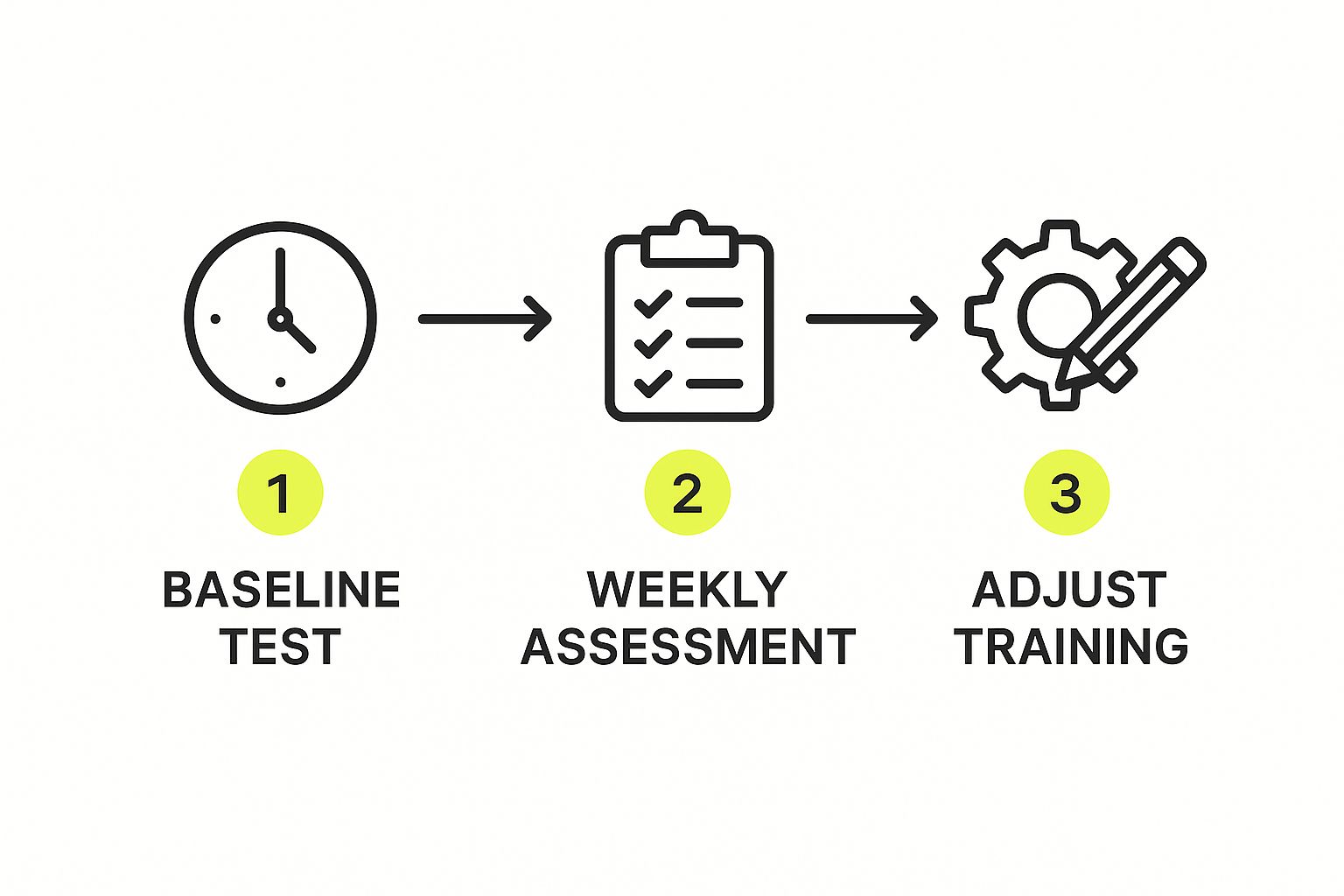
As you can see, it's a simple loop: establish your starting point, check in on your progress regularly, and then use that intel to tweak your training plan.
Use Your Smartphone Camera for On-Court Insights
While digital tests are great for raw speed, video analysis shows you what's actually happening on the court. It’s brutally honest. Record yourself doing a drill—that multi-ball feed drill we talked about is perfect for this. Later, watch it back in slow-motion on your phone.
You’re looking for a few specific things:
- The First-Step Delay: Is there a noticeable pause between the ball leaving your partner's racket and your feet starting to move? Even a fraction of a second here makes a massive difference.
- Racket Prep: Are you getting your racket back and ready early, or are you yanking it back at the last possible moment? A rushed swing is an inconsistent swing.
- Recovery: How quickly do you get back to the ready position after your shot? Lingering to admire your work is a quick way to get burned on the next ball.
This kind of feedback is just as valuable as your millisecond score from an app. It tells you why your reactions might feel slow. Maybe your brain is firing quickly, but your footwork is sloppy and inefficient. Video brings these truths to light.
My Two Cents: Don't just rely on numbers. Combine the hard data from reaction apps with the real-world visual feedback from video. That's how you get the full picture of your progress.
Adapting Your Drills When You Hit a Plateau
After a few weeks of consistent training and checking in, you’ll start to see a trend. Your reaction time should be dropping, and your movements on video will look sharper. But what happens when the progress stops? You’ve hit a plateau. Don’t panic—it happens to everyone.
A plateau isn't a sign of failure; it’s a sign that your body and brain have adapted to the current challenge. It’s time to turn up the heat.
- Stuck on a specific drill? Shorten the time between ball feeds, make the drill last longer, or add another layer of complexity, like calling out a target before you hit.
- Mastered a cognitive game? Find a more challenging level or a new app that pushes you in a different way.
Let the data guide you. If you’ve stalled for more than two weeks, grinding away at the same old routine won't help. You need to introduce a new stimulus to force your body to adapt again. This keeps your training from getting stale and ensures you’re always pushing forward.
Common Questions About Padel Reaction Training
When you first start a dedicated plan to sharpen your reflexes, a few questions always pop up. It’s natural to wonder what’s most effective and what to expect. Let's clear the air on some of the most common ones I hear from players.
How Often Should I Do Reaction Drills?
The key here is consistency, not cramming. You'll get much more out of short, sharp sessions 2-3 times per week than one huge, exhausting practice.
I always recommend aiming for a solid 15-20 minute block dedicated to reaction work. You can tack this onto your warm-up or make it a specific part of your on-court practice. This rhythm gives your brain and body time to build those faster connections without burning you out. Pushing too hard can actually make you slower, so pay attention to how you feel.
What Gear Do I Actually Need?
You don't need to break the bank on fancy gadgets. While pro-level tools like reaction light systems are great, you can build lightning-fast reflexes with just a few simple items.
Here’s a practical list to get you going:
- Reaction Ball: An absolute must-have. Its unpredictable bounces are perfect for training your response to chaotic situations.
- Resistance Bands: Ideal for firing up your glutes and core muscles during a dynamic warm-up.
- A Partner and a Basket of Balls: Nothing beats a good old-fashioned multi-ball feed drill for simulating real match pressure.
The best piece of "equipment" is your own focus. A simple drill done with total concentration is worth more than any expensive gear used mindlessly. Sharpening your reactions is just as much a mental game as a physical one.
When Will I See Results?
This is the big one, right? While patience is crucial, you'll probably feel a difference sooner than you think. Most players I've worked with report feeling quicker to the ball and more "switched on" within the first 2-3 weeks of consistent training.
However, seeing a real, measurable jump in your reaction test scores usually takes a bit longer—think 4-6 weeks.
Just remember that progress isn't a perfect, straight line. Some days you'll feel unstoppable, and other days you might feel a step slow. That's totally normal. Keep tracking your progress and stick with it. The goal is to build permanent, automatic reflexes, not just a temporary boost.
At Padel Rumors, we dig into the guides, gear, and pro-level insights that help you level up your game. Find everything you need to play smarter, faster, and better at Padel Rumors.


